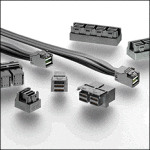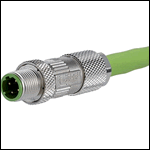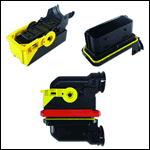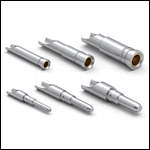Press-Fit Connectors in Harsh Automotive Applications
Press-fit connector technology provides highly reliable, cost-effective connections for harsh automotive applications, according to AVX’s Tom Anderson.
 As the electronic content in today’s automobiles continues to increase in complexity, spurred by the frenetic pace of technological advancements, so does the need for innovative interconnect solutions for printed circuit boards (PCBs) and electronic module assembly processes. Over the course of the last decade, solderless termination systems — which provide ultra-reliable, cold-welded connections to PCBs by creating continuous, gas-tight interfaces in even the harshest automotive and transportation environments — have been leading this charge.
As the electronic content in today’s automobiles continues to increase in complexity, spurred by the frenetic pace of technological advancements, so does the need for innovative interconnect solutions for printed circuit boards (PCBs) and electronic module assembly processes. Over the course of the last decade, solderless termination systems — which provide ultra-reliable, cold-welded connections to PCBs by creating continuous, gas-tight interfaces in even the harshest automotive and transportation environments — have been leading this charge.
At the heart of this technology’s continued success is eye-of-the-needle (EoN) press-fit or compliant pin geometry (see figure 1). First patented by AVX Interconnect in the 1970s for computer and telecom backplanes, the EoN compliant section stamping and coining process has been revamped several times to ensure that the marriage of material type and geometry continue to meet ever-changing automotive requirements, such as increased contact sizes, current ratings, and temperatures. Although the original patent has since expired, enabling other connector manufacturers to utilize the base EoN technology as well, routine revisions to the initial design continue to deliver maximum EoN performance, providing high and constant force with dual opposing beams in extreme high-temperature, -shock, and -vibration applications.

Figure 1: Above is a CAD drawing of AVX Interconnect’s Varipin press-fit pin contact technology, which provides a robust connection between a printed circuit board (PCB) and a pin. In this cross section, the contact (pin) part of the connector is inside a plated thru-hole on a PCB.
Due to the elimination of the soldering process with press-fit interconnects, the relatively large connectors and customized modules routinely employed in automotive applications are no longer exposed to the high soldering temperatures that are unavoidable when using most other competing connector technologies, especially with lead-free soldering processes, and can be produced from more cost-effective plastic materials. The press-fit zone of EoN compliant pin interconnect technology has been designed with enough elasticity to deform during the insertion process. This malleability prevents damage to the plated thru-hole (PTH) while also significantly reducing any imposed stresses that could jeopardize the long-term reliability of the connection, including common soldering defects like cold solder joints, bridging, and improper wetting.
Unique to the automotive module assembly process is the fact that PCBs can be directly pressed into modules, which capture and hold the EoN pins from stitched or insert-molded processes. This provides an extremely simple, cost-effective, and consistent assembly technique, and often even eliminates additional components and assembly time.
Some of the earliest and most prominent advancements in pin geometry, which is primarily responsible for enabling press-fit technology to withstand aggressive automotive environments, came at the expense of replacing individual pins in early, high-cost telecom backplanes. Today, however, it is just the opposite. Now, the automotive market demands permanent connections that combine both mechanical and electrical elements in the pin-to-board interface, providing one-and-done connections that don’t fatigue over time and due to temperature as traditional solder joints do. This functionality is where the technology’s dual name comes from. “Press-fit” refers to the termination process, and “compliant pin” references the performance level expected of the pin as it’s subjected to temperature extremes such as thermal shock and vibration.
Also unique to the automotive press-fit pin/connector market is the need for both power and high reliability in harsh environments with extreme temperatures, shock, and vibrations. These capabilities are enabled through a combination of material thicknesses and types (see figure 2). The reliability of these connections is facilitated by the commonality of the tin plating on both the pin and the PCB (as a result of the immersion plating process), which, by virtue of the press-in process, creates a metallic bond between the two components. Due to a combination of these matching base materials and optimized pin geometry, we can now achieve +170°C survivability for sensors mounted on an engine or demanding 20A (or higher) current-carrying capacity in complex mechatronic power steering or electric vehicle modules.
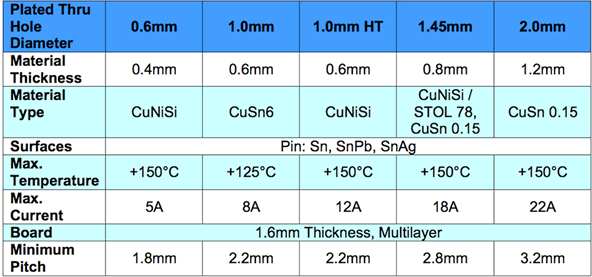
Figure 2: Specifications for various AVX Interconnect Varipin press-fit contacts
Press-fit pin technology plays an essential role in the high-reliability performance of every automotive system being developed today, ranging from advanced driver assistance systems (ADAS) to passive and active safety systems, transmission and gear control, and even dashboard and comfort systems. Regardless of the application, eye-of-the-needle press-fit compliant pins provide the ultimate solderless connection solution available to automotive systems designers.
[hr]
 Author Tom Anderson, connector product manager at AVX, has been in the connector industry for more than 30 years and has held a variety of product marketing positions. For the last six years, he has focused on developing new connector technologies for the automotive, industrial, and solid-state lighting markets.
Author Tom Anderson, connector product manager at AVX, has been in the connector industry for more than 30 years and has held a variety of product marketing positions. For the last six years, he has focused on developing new connector technologies for the automotive, industrial, and solid-state lighting markets.

